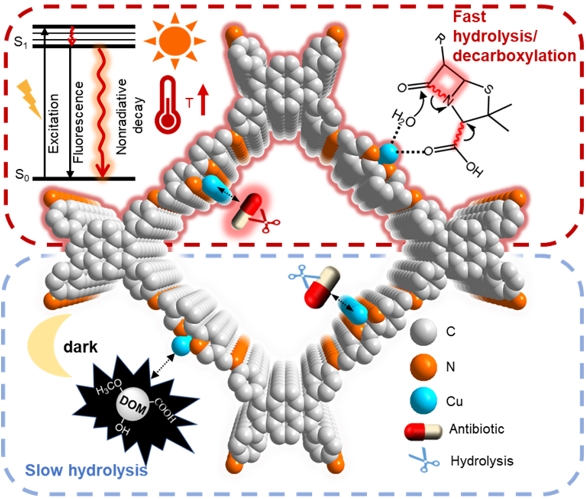Efficient Removal of Antibiotic Pollutants in Wastewater by Photothermal Catalytic Hydrolysis
Prof. MA Wanhong and his colleagues from the Institute of Chemistry, Chinese Academy of Sciences (ICCAS) and their collaborator posed a practical approach for the effective removal of antibiotic products through the in-situ heating catalytic hydrolysis sites by light illumination. This innovation paves the way for addressing challenging-to-degrade pollutants in water.
The work was published in Proceedings of the National Academy of Sciences of the United States of America and highlighted by Chemical & Engineering News from American Chemical Society (ACS).
The residual β-lactam antibiotics in various water sources and the subsequent dissemination of drug-resistance genes have raised widespread concern, but the economic and efficient methods for eliminating these antibiotics remain a significant challenge. The Lewis acid-catalyzed hydrolysis pathway emerges as a promising strategy to achieve this objective through breaking open the key four-membered β-lactam ring they share. However, the catalytic hydrolysis at room temperature is too slow to be adapted in practical application.
To address this problem, the researchers utilized a bipyridine linker on covalent organic framework (COF) materials to anchor Cu2+, creating a novel Lewis acid hydrolysis catalyst. This method can preserve the Lewis acid catalytic properties of Cu2+. Besides, Cu2+/COF can accumulate heat on limited catalytic sites during the photothermal conversion under visible light. The Cu2+ sites on the support could be locally heated to over 211 °C within 1 minute (gas/solid medium) by using a 300W Xe lamp. In an aqueous solution, the local temperature of catalytic sites could also be elevated to ~60 °C from room temperature, significantly enhancing the catalytic hydrolysis of the β-lactam bond. β-lactam antibiotics can be effectively hydrolyzed in waters for less than 10 minutes. Such photo-heating hydrolysis rate is about 24 times as high as under dark catalysis.This work opens an avenue for utilizing cleaner solar energy to degrade antibiotics.

Schematic representation of Cu2+/COF photothermal hydrolysis/decarboxylation of β-lactam antibiotics (Imaged by Li Jiazhen)
Contact:
Prof. MA Wanhong
Institute of Chemistry, Chinese Academy of Sciences
Email: whma@iccas.ac.cn





